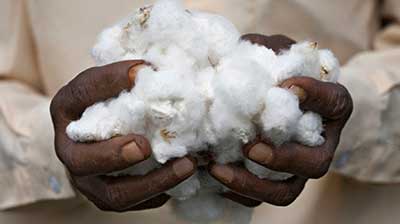Date: 03/03/2023
Relevance: GS-3: Major crop-cropping patterns in various parts of the country.
Key Phrases: clothing, bedding, fluffy fiber, synthetic pesticides and fertilizers, Social inequality, Thirsty crop, Better Cotton Initiative (BCI), Fair Trade Cotton, Organic Cotton Farming.
Why in News?
- Cotton, a soft, fluffy fiber that grows in a protective capsule around the seeds of the cotton plant, is one of the world's most important cash crops.
- It is used to make a wide range of products, including clothing, bedding, towels, and medical supplies.
- However, despite its ubiquity, the cotton industry is facing a number of serious challenges, ranging from environmental degradation to social inequality.
Key Highlights:
- Cotton productivity estimates were reported to be at their lowest in the North zone comprising of Punjab, Haryana, and Rajasthan at 518.4 kg lint per hectare.
- This is a significant decrease from the highest cotton yield recorded at 678.3 kg lint per hectare in 2019-20, now down by over 30%.
- According to the Agriculture Ministry's second advance estimates, the cotton output is estimated at 322 lakh bales (of 170 kg each), down by 48 lakh bales from the target of 370 lakh bales in 2022-23.
- Cotton productivity, which peaked at 566 kg lint per hectare in 2013-14, has continuously been decelerating since then, causing an imbalance in demand-supply of cotton and uncertainty in the cotton textile industry.
- In 2021-22, cotton yield reduced to 445 kg lint per hectare, down by 121 kg lint per hectare, an estimated loss of 85.4 lakh bales in 2021-22 alone over the optimal yield level of 2013-14.
- This dip in cotton production has forced the textile industry to rely on imports, which increased to 35.3 lakh bales worth ₹8,339.26 crores in 2018-19.

Challenges Associated:
- Heavy Use of Pesticides and Fertilizers :
- One of the biggest environmental challenges associated with cotton production is the heavy use of pesticides and fertilizers.
- It is also susceptible to a wide range of pests, including boll weevils, aphids, and whiteflies.
- To combat these problems, cotton farmers have traditionally relied on a cocktail of synthetic pesticides and fertilizers.
- However, these chemicals can have serious environmental and health consequences, contaminating soil and water supplies and posing risks to farm workers and nearby communities.
- Thirsty Crop :
- Cotton is notorious for being a "thirsty" crop, requiring large amounts of water to grow.
- Social Inequality :
- Cotton farmers in many parts of the world, particularly in developing countries, are often paid very low prices for their cotton, making it difficult for them to earn a decent living.
- In addition, many cotton farmers work in unsafe and exploitative conditions, with little access to basic human rights such as healthcare and education.
Note:
- 1 bale is equal to 217.7243376 kilogram.
Initiatives Launched to Address These Challenges:
- Better Cotton Initiative (BCI):
- The Better Cotton Initiative (BCI), aims to reduce the environmental impact of cotton farming while also promoting better working conditions for cotton farmers.
- BCI provides training and support to farmers to help them adopt more sustainable farming practices, such as crop rotation, intercropping, and integrated pest management.
- These practices can help to reduce the use of synthetic pesticides and fertilizers while also improving soil health and water management.
- Fair Trade Cotton :
- Fair trade cotton is grown by farmers who are paid a fair price for their cotton and who work in safe and fair conditions.
- Fair trade organizations work directly with cotton farmers to help them develop sustainable farming practices and improve their livelihoods.
- By buying fair-trade cotton, consumers can help to support these initiatives and promote more sustainable and equitable cotton farming practices.
- Organic Cotton Farming :
- Organic cotton farming involves growing cotton without the use of synthetic pesticides and fertilizers.
- This can help to reduce the environmental impact of cotton farming while also promoting healthier working conditions for farmers.
- Recycled Cotton :
- It involves using old cotton products such as clothing and bedding to create new cotton products.
- This can help to reduce the demand for new cotton and reduce the environmental impact of cotton production.
Conclusion:
- The cotton industry is facing a number of serious challenges, ranging from environmental degradation to social inequality.
- However, there are a number of initiatives underway to promote more sustainable and equitable cotton farming practices.
- By supporting these initiatives and choosing more sustainable cotton products, consumers can help to promote a more sustainable and equitable cotton industry in the future.
Source: The Hindu BL
Mains Question:
Q. Analyze the challenges faced by the cotton industry in India and discuss potential solutions to address them. (250 Words).








